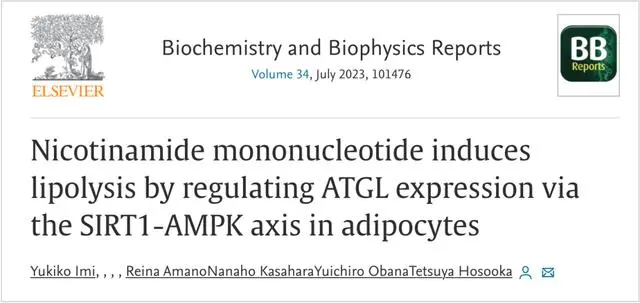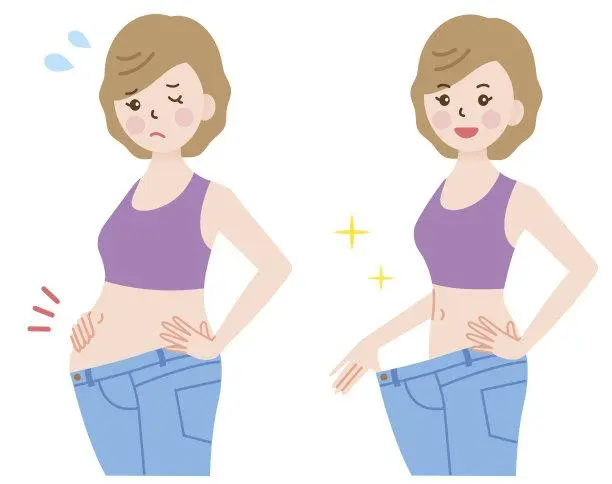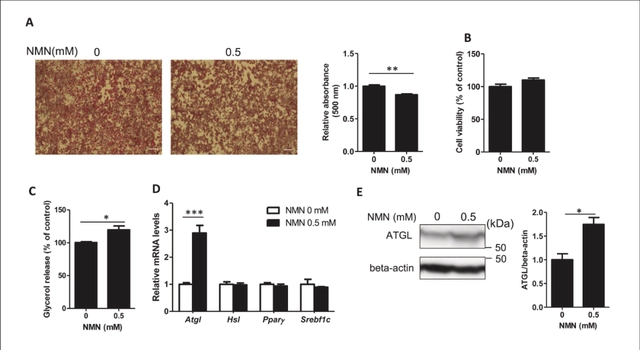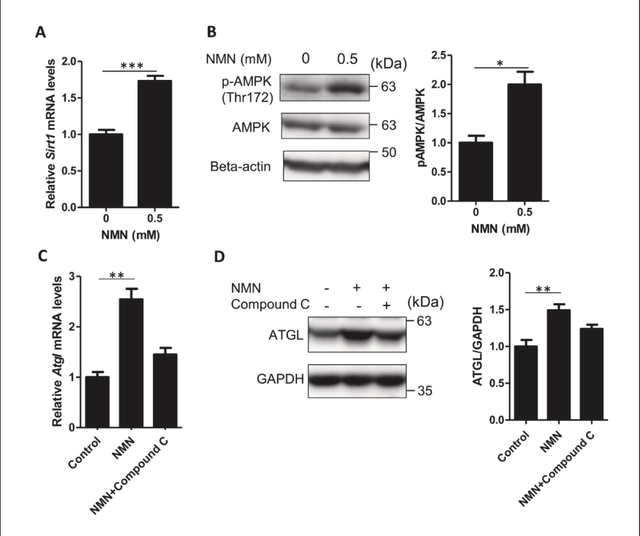In April 2023, a study published online in “Biochemistry and Biophysics Reports” by the Graduate School of Integrated Pharmacy and Nutritional Sciences of Shizuoka University in Japan once again confirmed the fat-reducing effect of β-Nicotinamide Mononucleotide: NMN can significantly reduce the amount of subcutaneous fat and the size of adipocytes. And the study also explored the fat reduction principle of NMN in detail.

1. NMN, improves metabolism and obesity problems in many aspects
In 2011, the research team of Professor Shinichiro Imai of Washington University in St. Louis found that NMN can help improve obesity and glucose intolerance caused by age. Since then, many studies have proven that β-Nicotinamide Mononucleotide can improve energy metabolism and obesity-related diseases in many aspects. This is because NMN can effectively increase the level of the important coenzyme NAD+ (nicotinamide adenine dinucleotide) in the human body, and NAD+ plays an important role in energy metabolism, DNA repair, and anti-aging.

Recent studies have found that the expression of NAMPT (nicotinamide phosphoribosyltransferase) is reduced in the white adipose tissue of higher weight body animals and humans, and NAMPT plays an important role in the recycling pathway of NAD+. Simply put, this means that higher-weight person animals and humans have lower NAD+ levels. Supplementing NMN can increase NAD+ levels, thereby improving obesity and the various problems it brings.
2. New exploration of NMN fat reduction mechanism
This Shizuoka University study further explored the mechanism of NMN fat reduction.
The amount of fat in our bodies is primarily determined by the size of fat cells, which is regulated by the balance between lipogenesis and lipolysis.
Adipose triglyceride lipase (ATGL) is considered the major lipolytic enzyme, which catalyzes the first step in lipolysis and converts intracellular triglycerides into diglycerides and free fatty acids. Studies have shown that ATGL expression is reduced in white adipose tissue of heavier person animals and humans.
In addition, systemic or adipose tissue-specific ATGL deficiency in mice leads to increased fat mass, and in turn increased ATGL expression can ameliorate diet-induced obesity and related metabolic disorders in mice.
This study found that NMN can induce lipolysis by regulating ATGL expression through the SIRT1-AMPK axis in adipocytes.
After taking NMN, the amount of subcutaneous fat in mice on a high-fat diet significantly reduced, and the size of adipocytes in the subcutaneous fat decreased with β-Nicotinamide Mononucleotide treatment.
Consistent with changes in fat mass and adipocyte size, ATGL expression in subcutaneous fat increased significantly with NMN treatment.
1. NMN induces lipolysis by increasing ATGL expression in differentiated 3T3-L1 adipocytes.

Treatment with 0.5mM β-Nicotinamide Mononucleotide for four days significantly reduced lipid accumulation in differentiated 3T3-L1 adipocytes, while this concentration of β-Nicotinamide Mononucleotide did not affect cell viability. NMN treatment increases the concentration of glycerol in the culture medium of 3T3-L1 adipocytes. These results indicate that β-Nicotinamide Mononucleotide reduces lipid accumulation in 3T3-L1 adipocytes by enhancing lipolysis.
2. NMN enhances ATGL expression through the SIRT1/AMPK pathway in 3T3-L1 adipocytes.

NMN treatment significantly increased sirtuin1 (Sirt1) expression in 3T3-L1 adipocytes. AMPK a key molecule in regulating energy metabolism and has shown to activated by SIRT1-mediated enhancement of LKB1 activity through LKB1 deacetylation.
NMN treatment increases AMPK phosphorylation in 3T3-L1 adipocytes. These findings indicate that the SIRT1-AMPK pathway involved in the regulation of ATGL expression by β-Nicotinamide Mononucleotide.
3. NMN inhibits adipocyte volume in subcutaneous adipose tissue of diet-induced higher weight body mice

Mice fed a high-fat diet with β-Nicotinamide Mononucleotide for eight weeks. Compared with mice in the control group, mice in the β-Nicotinamide Mononucleotide group had significantly lower body weights. Consistent with changes in body weight, β-Nicotinamide Mononucleotide significantly reduced subcutaneous fat mass, while epididymal fat mass unchanged.
Histological examination showed that adipocyte size in subcutaneous adipose tissue reduced after NMN treatment, indicating that β-Nicotinamide Mononucleotide treatment improved adipocyte hypertrophy. Consistent with changes in fat mass and adipocyte size, ATGL protein levels increased slightly after β-Nicotinamide Mononucleotide treatment.
NMN fat loss principle
- (1) Decreased fat triglyceride lipase (ATGL) leads to increased fat mass;
- (2) β-Nicotinamide Mononucleotide induces lipolysis by regulating ATGL expression through the SIRT1-AMPK axis in adipocytes;
- (3) NMN significantly reduced the amount of subcutaneous fat in mice on a high-fat diet, and the size of adipocytes in subcutaneous fat decreased with β-Nicotinamide Mononucleotide supplementation.




